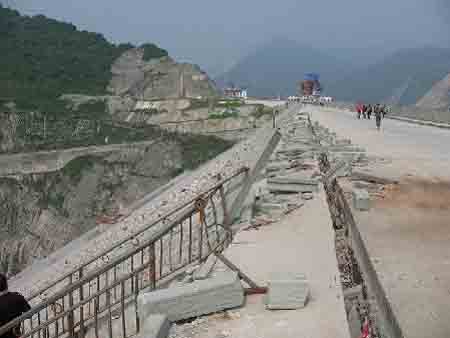|

|
|
The Zipingpu Dam after the earthquake.
|
"There are four known RIS cases above 6.0-Magnitude around the world, including one in Xinfengjiang of China and another three in Zambia, Greece and India. All four were far more powerful than quakes that had been previously recorded in the regions," Fan said to Xinhua.
Nonetheless, Ji said the reservoir could not result in a 8.0-magnitude earthquake, unless it was filled with dynamite instead of water.
He added that a 8.0-magnitude quake is close to 1,000 times more powerful than a magnitude-6.0 one.
The American journal Science published a news story on the "human trigger" for the Wenchuan Earthquake. It quoted Christian Klose, a Columbia University public hazards researcher, by saying the "several hundred million tonnes of water piled behind dams" both eased "the squeeze on the fault, weakening it, and increased the stress tending to rupture the fault."
Klose did not mention any specific dam, but he said the effect of the stress of dam water was "25 times that of a year's worth of natural stress loading from tectonic motions."
"When the fault did finally rupture, it moved just the way the reservoir loading had encouraged it to," he said.
He concluded in a non-refereed abstract at the Fall Conference of the American Geophysical Union last month "the root cause of triggering the Wenchuan earthquake may have stemmed from local and rapid mass changes on the surface."
An email posted on Ji's blog (http://www.sciencenet.cn/u/Majorite/) from Zhou Hua-wei, a geophysics professor at the Texas Tech University, also said Klose's abstract was "not very convincing."
Klose said in the abstract that Logmenshan region, where the earthquake rupture was, had no major seismic activity for more than one million years.
"But the clear line of the Longmenshan Fault from a satellite photo in such a region of a high-precipitation climate already reveals its seismically active nature," Zhou wrote.
"The average recurrence interval for M-8 earthquakes is in a range of 3,000-6,000 years in the Longmenshan region based on geological data", Ji Shaocheng said.
"The conference abstract was not peer reviewed ... and is flawed in some facts," he said.
"I think that Dr. Klose ought to present more detailed evidence in a journal paper, such as the Journal of Geophysical Research, that will offer more room for a vigorous analysis," Zhou said.
Klose turned down an interview request from Xinhua, but said he would be open for statement after his paper is peer reviewed and accepted for publication.